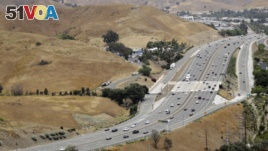01 September, 2019
Transportation officials in California are preparing to build the world's largest road crossing for wildlife.
The crossing will be built over the busy 101 freeway near Los Angeles. It aims to give different kinds of animals a way to safely pass through to open areas currently blocked by roads.
Among the animals expected to use the crossing are mountain lions and other large cats, coyotes, deer, lizards and snakes.
The $87-million bridge project is being financed mostly with private money, including support from conservation groups. It will be the second animal-crossing bridge in California.

In this July 25, 2019, photo, U.S. Highway 101 passes between two separate open space preserves on conservancy lands in the Santa Monica Mountains in Agoura Hills, Calif. (AP Photo/Marcio Jose Sanchez)
Officials say the crossing will be the first of its kind near a major city. It also will reportedly be the largest in the world. It will stretch 61 meters above 10 lanes of traffic in the city of Agoura Hills.
Beth Pratt of the National Wildlife Federation spoke to The Associated Press about the project.
"When the freeway went in, it cut off an ecosystem. We're just now seeing impacts of that," Pratt said.
The area, about 56 kilometers northwest of downtown Los Angeles, is near the Santa Monica Mountains. The mountains run along America's Pacific coast and through parts of Los Angeles.
Scientists have followed the movements of mountain lions in the area electronically. Their research showed that roads were blocking many animals and trapping them in the Santa Monica Mountains – away from other wildlife, food and other resources.
Researchers say this has led to the threat of genetic collapse for area mountain lions. Being cut off from their natural environment has driven the local mountain lion population to inbreed.
A major study published this year warned that such inbreeding could lead to the disappearance of big cats within 15 years. But the problem can be helped if the animals are able to connect with other populations to increase the mating possibilities.
"They can't get out of here to get dates," said Beth Pratt about the mating difficulties. She joked that many people living in Los Angeles should be able to relate to how the city's traffic problems can get in the way of one's personal love interests.
About 300,000 vehicles travel through the stretch of freeway each day. People who live in the area are used to seeing many kinds of creatures near their homes. Officials from the National Wildlife Federation say a large majority of people in the area favor the crossing.
One of the project's designers, Clark Stevens, said the goal is to make the surface of the bridge look as natural as possible. The design will include a total of about 3 hectares of land.
"Ideally the animals will never know they're on a bridge," Stevens told the AP. "It's landscape flowing over a freeway. It's putting back a piece of the ecosystem that was lost."
I'm Bryan Lynn.
The Associated Press reported on this story. Bryan Lynn adapted the report for VOA Learning English. Ashley Thompson was the editor.
We want to hear from you. Write to us in the Comments section, and visit 51VOA.COM.
_________________________________________________________________
Words in This Story
freeway – n.a long, wide road, usually used by traffic travelling fast over long distances
conservation – n.the protection of animals, plants, and natural resources
lane – n.part of a road that is separated from the other parts
ecosystem – n.a biological community of interacting organisms and their physical environment
impact – n.the strong effect or influence something has on a person or situation
inbreed – n.the mating of closely related beings
landscape – n.the appearance of an area of land